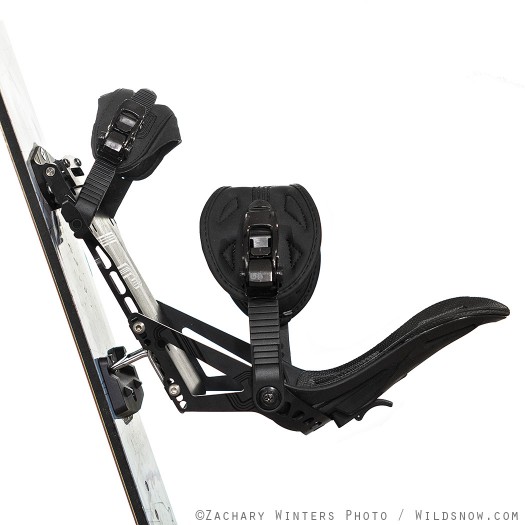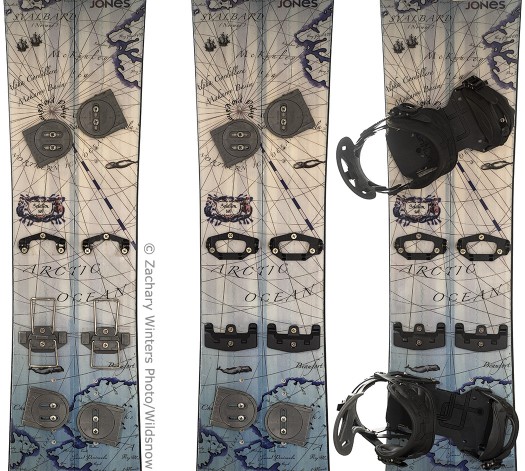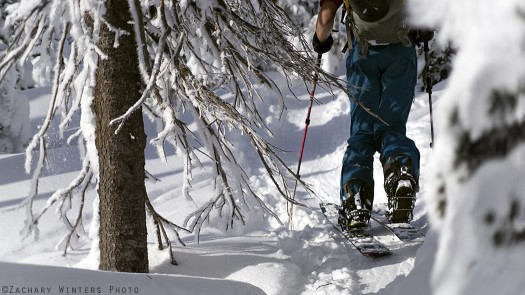Zachary Winters
As a Spark R&D splitboard binding user since 2009, I was excited when I caught wind that the company had a new binding system set for release this year. The new Tesla system has eliminated the long-lived pin system found in many splitboard bindings, reduced weight, and aims to improve transition speed and downhill performance. Spark R&D has released two new bindings employing the Tesla system: the Afterburner and the Magneto, prioritizing stiffness/response and weight respectively.

The Afterburner, a new splitboard binding from Spark R&D with the lower of two climbing wires engaged.
Since this is the first blog entry specifically regarding Spark R&D binding products, and only the second splitboard binding specific review here at Wildsnow.com, allow me to provide a bit of background. Spark R&D was born in Bozeman, Montana in 2005. Their popularity grew rapidly in their early years as splitboarding boomed. Fast forward to 2009. I picked up my first pair of Sparks, the “Fuse”, and was among the enlightened. Since then Spark has made gradual improvements to the original design in weight, stiffness, and pin bushing durability, dropping the name “Fuse” in favor of “Blaze” and “Burner” – but the foundation of the interface has stayed the same through each of the subsequent binding models until this year.
When Karakoram mixed things up by releasing their lightweight puck and pin free interface, Spark R&D fans were eager to see a new interface from Spark as well. Spark created a prototype splitboard binding that featured an extreme makeover of the splitboard interface called the Edison. In favor of simplicity, durability, and snow/ice tolerance (common reasons for Spark users not yet jumping on the Karakoram bandwagon), Spark discontinued development of the Edison and decided to keep things a bit simpler with the Tesla.
To clear up any confusion with the Edison system, the Tesla still uses the enduring Voile slider pucks and either Voile’s Split Hooks or Karakoram’s Splitboard Clips.

The hardware set-up for older Spark bindings (left), the Afterburner (center), and with the bindings attached in ride mode (right). Both toe and heel touring brackets are included with the bindings.
The Tesla system’s most obvious change is the absence of the steel pins (or lighter aluminum LT Pins) that have been the centerpiece of all of Spark’s previous bindings, as well as Voile’s Light Rail binding and the “Alpine Trekker” for splitboarders: the Voile slider tracks. There are a few reasons I’m happy to see the pins gone. Firstly, they are heavy. Spark’s LT pins helped in this category a bit, but there was still unnecessary metal between the two pivot points. Secondly, if you lose a pin you’ll quickly remember that feeling of watching your skier friends skinning while you drown in your own sweat trying to keep up boot-packing. The fix: carry an extra pin, unfortunately increasing weight even more.
In place of pins, Tesla system bindings have a “snap ramp”, which is a hinged plate under the toe of the baseplate that snaps down to secure the binding for both touring and descending. For touring, there are two short, permanently mounted pegs (in the same diameter as the ancestral pins) that pivot inside what Spark calls a “Side Lock Touring Bracket” (included with the both Tesla bindings). The pegs are inserted to the side of the touring bracket, and the snap ramp is depressed to secure the assembly. In transition at the top of the skin track, the binding slides onto the Voile pucks (nothing new here), and when the snap ramp is depressed the binding is locked into place.
The heel lift climbing wires are different, too. While most other splitboard bindings use a tele-like heel lift wire mounted to the ski, the wires on the Tesla bindings are attached to the bindings themselves and land with each step on a catch plate mounted on the ski (not unlike the Marker touring bindings). There are two different heights, one nested inside the other. My first impression was: why lift that weight with each step? I still don’t know that it’s the most efficient, but including the climbing wires the bindings are still lighter than its non-Tesla brother, the Burner. The wires are also wider, aiming to have better weight transfer to the ski edge on sidehills. While a good idea, I think the lateral stiffness of most boots and overall stiffness of the ski are weaker links than the climbing wire. However I do prefer the new wires for their ease of use (see video). They are easily pushed down from your heel rather than needing to be pulled up from the ski. The longer of the two wires engages first, so in order to use the shorter wire, both must be engaged, then the longer one retracted. Despite the extra step, I still find this faster than the old system.
Transitions with Spark R&D Afterburner binding from Zachary Winters on Vimeo.
The new bindings were also released with a new crampon. The Sabretooth Crampon, as Spark is calling it, is 61g lighter than the crampon for the non-Tesla Sparks. This weight savings is due to the fact that the crampon does not need its own set of climbing wires like its predecessor as a result of the in-binding wires. The crampon is also slotted into the touring bracket from the side, rather than vertically. I have not had a chance to try out the new crampons in the field.
Over the last couple months of testing the Afterburner binding, I have found this new interface to transition faster and to be more resilient to snow and ice buildup. And the reason is fairly simple; instead of lining up four holes with the pin to tour and two holes to ride (all of which must be snow free), only two must be lined up to tour and none to ride. The snap ramp can be closed even with snow underneath it; the ramp effectively forces the snow from that space. I have found myself spending less time clearing ice from my bindings and more time getting an extra sip of water or snapping a photo before heading back up the skin track.
Note: After a snowy ride in the back of my truck returning from BC, one of the snap ramps iced in a way that prevented it from fully opening until it thawed. I have not had this happen in the field, but it seems possible under the right conditions.

Table: Advertised weights and prices compared for various Spark R&D binding models and the Voile Light Rail. Karakoram is not included because of different hardware weights. Karakoram prices range from $600-$850.
Beyond our regular guest bloggers who have their own profiles, some of our one-timers end up being categorized under this generic profile. Once they do a few posts, we build a category. In any case, we sure appreciate ALL the WildSnow guest bloggers!

